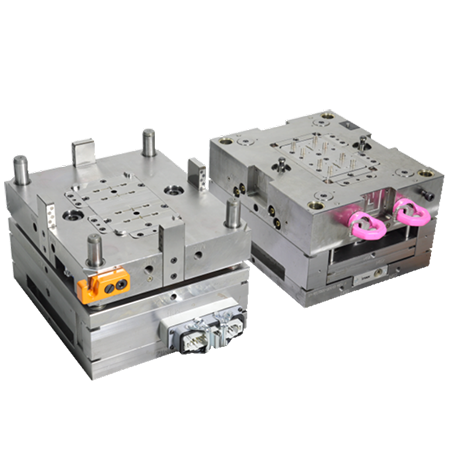Industry Dynamics
Types and Selection of Injection Mold Steel
2023-01-14 18:55:01
The types and selection of injection mold steel, Xinxin uses many types of steel for manufacturing injection molds, and their performance, processing performance, and market supply prices vary. Below, we will introduce several commonly used materials to you.

1. Carbon structural steel
Carbon structural steel has low prices and good cutting performance. When the carbon content is low, the strength is poor, and when the carbon content is high, the strength is high but the hardenability is poor. The heat treatment deformation is large, and the polishing performance of carbon structural steel is not very good. Carbon structural steel can be used to manufacture injection molded parts with low requirements for dimensional accuracy and surface roughness, and small production batches of plastic parts. In addition, it can also be used to manufacture guide pillars, guide sleeves, and injection mold support components.
2. Alloy structural steel
The types and selection of injection mold steel, the performance of alloy structural steel is better than that of carbon structural steel, and the service life of components used in manufacturing injection molds is longer than that of carbon structural steel. According to the classification of main alloying elements, the alloy structural steel used in plastic molds can be divided into chromium steel, chromium nickel steel, chromium molybdenum steel, chromium nickel molybdenum steel, chromium molybdenum aluminum steel, chromium manganese titanium steel, etc. Although alloy structural steel has better performance than carbon structural steel, its hardenability, heat treatment deformation, and other properties have not been greatly improved. It is generally not suitable for making integral four molds and convex molds with complex shapes or larger dimensions. In some large and functional tools, it is used to make local sizes smaller. In addition, movable molded parts or molded inserts that require high hardness and wear resistance are still suitable.
3. Carbon tools
Carbon tool steel has better strength, convenience, and wear resistance than structural steel, but its toughness is poor, hardenability is poor, and heat treatment deformation is large. Carbon tool steel includes T7, T7A, T8, T8A, T10, T10A, etc. They can all be used to make molded parts for injection molds in situations where the size of the plastic parts is small, the shape is simple, the heat treatment deformation has little effect, and the production batch is relatively large. In addition, it can be used to make molding inserts in complex molds, and is often used to make injection mold parts such as guide pillars, guide sleeves, push rods, and reset rods.
4. Alloy tools
The types and selection of injection mold steel, as well as the hot work mold steel and cold work mold steel in steel alloy tool steel, can not only manufacture metal forming injection molds, but also other plastic forming molds. Many of their properties are better than carbon structural steel and carbon tool steel, but they are relatively expensive. They are usually mainly used to manufacture injection molded parts with complex shapes, high precision requirements, and large production batches, especially in injection molds for forming thermosetting plastics or reinforced plastics.
Cold work mold steel is divided into two types: low alloy and high alloy. The former includes 9Mn2V, 9SiCr, CrWMn, 9GrWMn, etc., while the latter includes Crl2MoV, Cr6WV, etc. Low alloy cold work mold steel is relatively easy to cut and process, with better hardenability, wear resistance, and polishing properties than structural steel. The heat treatment deformation is also relatively small. Dongguan Machiko Injection Mold Processing Factory has a relatively cheap price among mold steel types, which is suitable for manufacturing molded parts with complex shapes and high accuracy in large-scale production of thermoplastic parts. High alloy cold work injection mold steel has high strength and hardness, good wear resistance, oxidation resistance, corrosion resistance, and polishing performance, and small heat treatment deformation. However, its cutting ability, grinding ability, and toughness are relatively poor, and its price is also expensive. Its application range is similar to low alloy cold work mold steel, but its service life is relatively long. It is widely used in the forming molds of reinforced plastics or thermosetting plastics. The bearing steel GCr15 can also be used as a cold work mold steel, with good hardenability, hardenability, and wear resistance. It is mainly used in injection molds for sliding parts with high wear resistance requirements.
Hot work mold steel includes: 3Cr2W8V, 5CrMnMo, 5CrNiMo, 4Cr5MoSiV, 4Cr5MoSiV1, etc. Their characteristics are good high-temperature mechanical properties and heat resistance, as well as impact resistance, which can withstand high working temperatures and pressures. They are particularly suitable for manufacturing formed parts of various plastic molds, but they are expensive.
5. Stainless steel
The types and selection of injection mold steel, including 40Cr13, 95Cr18, 14Cr17Ni2, etc., can be used by Xinxin to make injection mold parts. They can work for a long time under certain temperature and corrosion conditions, and their mechanical and physical properties remain unchanged. Therefore, when forming plastic parts that are prone to producing corrosive gases, stainless steel can be used to manufacture molded parts or other injection mold parts that come into contact with plastic melt, such as sprue sleeves, runner plates, push rods, and pull rods. But stainless steel is much more expensive than ordinary steel, and its processing performance is also relatively poor.

